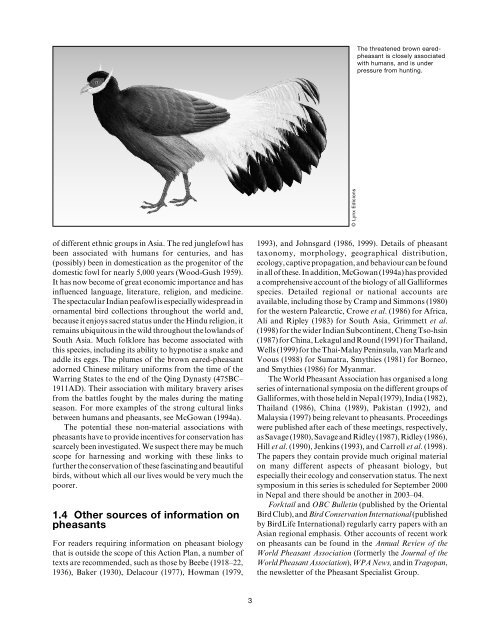Pheasants: Status Survey and Conservation Action Plan ... - IUCN
Pheasants: Status Survey and Conservation Action Plan ... - IUCN
Pheasants: Status Survey and Conservation Action Plan ... - IUCN
You also want an ePaper? Increase the reach of your titles
YUMPU automatically turns print PDFs into web optimized ePapers that Google loves.
The threatened brown earedpheasant<br />
is closely associated<br />
with humans, <strong>and</strong> is under<br />
pressure from hunting.<br />
© Lynx Edicions<br />
of different ethnic groups in Asia. The red junglefowl has<br />
been associated with humans for centuries, <strong>and</strong> has<br />
(possibly) been in domestication as the progenitor of the<br />
domestic fowl for nearly 5,000 years (Wood-Gush 1959).<br />
It has now become of great economic importance <strong>and</strong> has<br />
influenced language, literature, religion, <strong>and</strong> medicine.<br />
The spectacular Indian peafowl is especially widespread in<br />
ornamental bird collections throughout the world <strong>and</strong>,<br />
because it enjoys sacred status under the Hindu religion, it<br />
remains ubiquitous in the wild throughout the lowl<strong>and</strong>s of<br />
South Asia. Much folklore has become associated with<br />
this species, including its ability to hypnotise a snake <strong>and</strong><br />
addle its eggs. The plumes of the brown eared-pheasant<br />
adorned Chinese military uniforms from the time of the<br />
Warring States to the end of the Qing Dynasty (475BC–<br />
1911AD). Their association with military bravery arises<br />
from the battles fought by the males during the mating<br />
season. For more examples of the strong cultural links<br />
between humans <strong>and</strong> pheasants, see McGowan (1994a).<br />
The potential these non-material associations with<br />
pheasants have to provide incentives for conservation has<br />
scarcely been investigated. We suspect there may be much<br />
scope for harnessing <strong>and</strong> working with these links to<br />
further the conservation of these fascinating <strong>and</strong> beautiful<br />
birds, without which all our lives would be very much the<br />
poorer.<br />
1.4 Other sources of information on<br />
pheasants<br />
For readers requiring information on pheasant biology<br />
that is outside the scope of this <strong>Action</strong> <strong>Plan</strong>, a number of<br />
texts are recommended, such as those by Beebe (1918–22,<br />
1936), Baker (1930), Delacour (1977), Howman (1979,<br />
1993), <strong>and</strong> Johnsgard (1986, 1999). Details of pheasant<br />
taxonomy, morphology, geographical distribution,<br />
ecology, captive propagation, <strong>and</strong> behaviour can be found<br />
in all of these. In addition, McGowan (1994a) has provided<br />
a comprehensive account of the biology of all Galliformes<br />
species. Detailed regional or national accounts are<br />
available, including those by Cramp <strong>and</strong> Simmons (1980)<br />
for the western Palearctic, Crowe et al. (1986) for Africa,<br />
Ali <strong>and</strong> Ripley (1983) for South Asia, Grimmett et al.<br />
(1998) for the wider Indian Subcontinent, Cheng Tso-hsin<br />
(1987) for China, Lekagul <strong>and</strong> Round (1991) for Thail<strong>and</strong>,<br />
Wells (1999) for the Thai-Malay Peninsula, van Marle <strong>and</strong><br />
Voous (1988) for Sumatra, Smythies (1981) for Borneo,<br />
<strong>and</strong> Smythies (1986) for Myanmar.<br />
The World Pheasant Association has organised a long<br />
series of international symposia on the different groups of<br />
Galliformes, with those held in Nepal (1979), India (1982),<br />
Thail<strong>and</strong> (1986), China (1989), Pakistan (1992), <strong>and</strong><br />
Malaysia (1997) being relevant to pheasants. Proceedings<br />
were published after each of these meetings, respectively,<br />
as Savage (1980), Savage <strong>and</strong> Ridley (1987), Ridley (1986),<br />
Hill et al. (1990), Jenkins (1993), <strong>and</strong> Carroll et al. (1998).<br />
The papers they contain provide much original material<br />
on many different aspects of pheasant biology, but<br />
especially their ecology <strong>and</strong> conservation status. The next<br />
symposium in this series is scheduled for September 2000<br />
in Nepal <strong>and</strong> there should be another in 2003–04.<br />
Forktail <strong>and</strong> OBC Bulletin (published by the Oriental<br />
Bird Club), <strong>and</strong> Bird <strong>Conservation</strong> International (published<br />
by BirdLife International) regularly carry papers with an<br />
Asian regional emphasis. Other accounts of recent work<br />
on pheasants can be found in the Annual Review of the<br />
World Pheasant Association (formerly the Journal of the<br />
World Pheasant Association), WPA News, <strong>and</strong> in Tragopan,<br />
the newsletter of the Pheasant Specialist Group.<br />
3
















